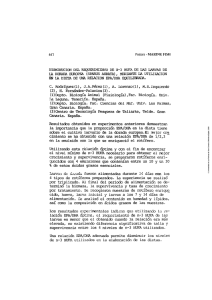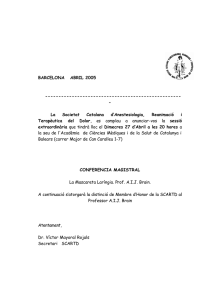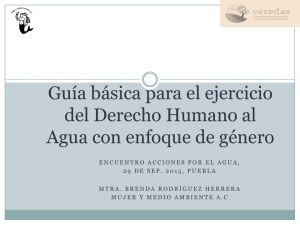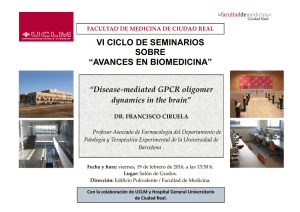La Corriente de Humboldt
Anuncio
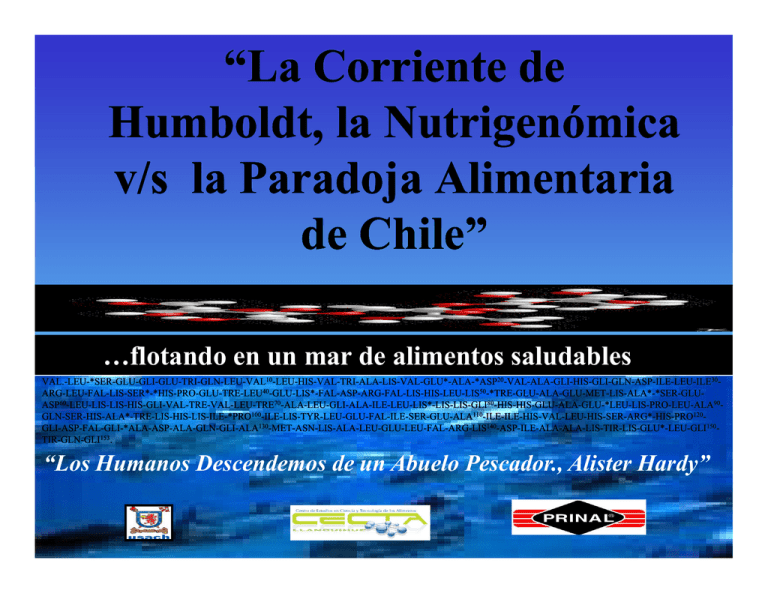
“La Corriente de H b ldt la Humboldt, l Nutrigenómica N t i ó i v/s la Paradoja Alimentaria de Chile” …flotando en un mar de alimentos saludables VAL.-LEU VAL.LEU--*SER *SER--GLU GLU--GLI GLI--GLU GLU--TRI TRI--GLN GLN--LEU LEU--VAL10-LEU LEU--HIS HIS--VALVAL-TRI TRI--ALA ALA--LIS LIS--VALVAL-GLU* GLU*--ALA ALA--*ASP20-VALVAL-ALA ALA--GLI GLI--HIS HIS--GLI GLI--GLN GLN--ASPASP-ILE ILE--LEU LEU--ILE3040 50 ARG--LEU ARG LEU--FAL FAL--LIS LIS--SER* SER*--*HIS*HIS-PROPRO-GLU GLU--TRE TRE--LEU -GLU GLU--LIS* LIS*--FALFAL-ASP ASP--ARG ARG--FALFAL-LIS LIS--HIS HIS--LEU LEU--LIS -*TRE *TRE--GLU GLU--ALA ALA--GLU GLU--MET MET--LIS LIS--ALA* ALA*--*SER *SER--GLU GLU-ASP60-LEU LEU--LIS LIS--LIS LIS--HIS HIS--GLI GLI--VALVAL-TRE TRE--VALVAL-LEU LEU--TRE70-ALA ALA--LEU LEU--GLI GLI--ALA ALA--ILE ILE--LEU LEU--LIS* LIS*--LIS LIS--LIS LIS--GLI80-HIS HIS--HIS HIS--GLU GLU--ALA ALA--GLU GLU--*LEU *LEU--LIS LIS--PRO PRO--LEU LEU--ALA90GLN--SER GLN SER--HIS HIS--ALA* ALA*--TRE TRE--LIS LIS--HIS HIS--LIS LIS--ILE ILE--*PRO100-ILE ILE--LIS LIS--TYR TYR--LEU LEU--GLU GLU--FALFAL-ILE ILE--SER SER--GLU GLU--ALA110-ILE ILE--ILE ILE--HIS HIS--VALVAL-LEU LEU--HIS HIS--SER SER--ARG* ARG*--HIS HIS--PRO120130 140 GLI--ASP GLI ASP--FAL FAL--GLI GLI--*ALA *ALA--ASPASP-ALA ALA--GLN GLN--GLI GLI--ALA -MET MET--ASN ASN--LIS LIS--ALA ALA--LEU LEU--GLU GLU--LEU LEU--FALFAL-ARG ARG--LIS -ASPASP-ILE ILE--ALA ALA--ALA ALA--LIS LIS--TIR TIR--LIS LIS--GLU* GLU*--LEU LEU--GLI150153 TIR--GLN TIR GLN--GLI . “Los Humanos Descendemos de un Abuelo Pescador., Alister Hardy” Corrientes Marinas Relacionadas con la Funcionalidad y Bondades en Salud de los Recursos Pesqueros Influencia de la Corriente del G lf en Noruega Golfo N +4-6ºC 4 6ºC Influencia de la Corriente de Humboldt en Chile Modif. V.H. Gutierrez, 2010 ¿Qué Beneficios nos Entrega la Corriente de Humboldt? •Ecosistema Ecosistema Marino de Mayor Calidad Productiva del Mundo (300g/ m2-Yr), con una Profundidad Promedio de 400 mts. y Ancho de 600Km., Velocidad de 40 - 60 mts/h. •Producción de Alimentos Marinos con Función Terciaria (Protectores del Sist. Inmune Nervioso etc.) •Gran G Productividad P d ti id d de d Fosfolípidos, F f lí id AG-PUFA AG PUFA C Como EPA (C20:5n-3), DPA (C22:5n-3), DHA (C22:6n-3) •7-10ºC 7-10 C. más Fría que Similar Latitud (condición de carácter única). •A< tº >Producción de Glicoproteínas, p , Glicofosfolípidos, p , aa. Libres (CBPM). •Efecto Coriolis NUTRIGENOMIC GENOMIC TRANSCRIPTOMIC PROTEOMIC METABOLOMIC DNA mRNA Protein Metabolits DNA Methylation y “Death is a crisis of errors in the replication of DNA ” Nutrigenomics and Nutrition Metabolomic LMWC Nutrigenomic Nutrient-gene int. Nutrient-gene interaction: 1. 2. 3. Direct interaction (induce gene expression) Epigenetic interaction (gene exp. Chronically altered. altered Genetic variations (S.N-polymorphisms (SNPs). Nutrition Diet Telomere Shorteningg and Chromosomal Instability y Low and High Energy Intake(Kcal) B POST GENOMIC ERA A • Radical Changes in Nutrition Sciences ( answer: to what and how to eat) “SEMAFORONTE” • Total Changes in Alimentary Pyramid FP. • Omic Sciences ( Funcional Genomic), (Sir2-Sirt1, Sch9, Rec-A), Proteomic, Transcriptomic, Metabolomic, Nutrigenomic, nanomedicine, Ali Alimentary t Bi t i h Biostoichometry, t Crionutrition). Ci t iti ) • PCR (Polymerase Chain Reaction), Algoritms like Blast and Fasta, Fasta Microrrays, Microrrays Microchips among others. “FUNCTIONAL FOOD” vs. TOKUHO Food Functional Food I. Nutrition (Primary function) II. Sensory satisfaction (flavor, aroma), (Secundary function) III F III. Fortification tifi ti modulation of physical system Food F d that th t claims l i its function (Not necessarily clinically proven) TOKUHO (FOSHU) (Tertiary function) ( (inmune, , nerv. etc. ) Food F d product d t approved to claim its clinically proven function Ref: H. Hosoya Copyright JHNFA TOKUHO (FOSHU) Rec--A Rec Sch--9 Sch Ca Na/k pump LYSOPHOSPHOLIPS Blood Brain Barrier I LMWC DHA Se sn - 1,3 Sirt--1 Sirt GLUCOSE Cu Altered expression of Transtyretin Transtyretin,, α-synuclein synuclein,, calmadulins ( synaptic plasticity and learning) ARA sn – 1,3 , Zn Glutamate Fe “Ishoku Dogen” (Healthy Eating to Prevent Disease” PA sn - 2 Glycine Ciencias Ómicas y Nutrición “NUTRIGENÓMICA” “…Obtención de Servicios de Calidad y Seguridad Alimentaria con Baja Hipoteca Energética y Catabólica y Alta Fidelidad en la Copia del ADN…” “Nutrición Personalizada” “Nutrición Inteligente” “Alimentación “Ali t ió Saludable” “Alimentación Funcional” “Alimentación Inteligente” “Alimentación Celular” El Desvelamiento del Genoma Humano, las Ciencias Ómicas, algunos Conocimientos Vertidos. • Las Bajas Temperaturas, los glicofosfolípidos, los ácidos grasos poliinsaturados n-3 en la posición i ió sn-1,3 1 3 del d l TG TG. permiten it ell desarrollo d ll de d la l inteligencia i t li i humana. h • Las Bajas Temperaturas permiten que las especies silvestres contengan un mayor porcentaje de péptidos o Compuestos de Bajo Peso Molecular (CBPM), los cuales fidelizan la copia del ADN h humano, i impactando t d directamente di t t a nivel i l celular. l l • Las Bajas Temperaturas y alta luminosidad e irradiancia permiten que algunos vegetales desarrollen una alta capacidad antioxidante. • Las Bajas Temperaturas, la Actividad Física y la vida silvestre permiten una mayor actividad de la enzima D9D y la homeostasis de la Bomba Na/K, lo que explica una mayor síntesis de ácido oleico a partir del ácido araquidónico y una mejor liberación del Na. • Los genes Sirt-1, Sch-9, Rec-A, genes de la longevidad, inmuno respuesta y ADN respectivamente. reparador del La Corriente de Humboldt Generadora de la Materia Fundamental de la Vida Proteínas CBPM 70% CBPM Fosfolípidos 90% F Fosfolípidos f lí id (de los lípidos Totales) AG n-3 50% DHA La Corriente de Humboldt Generadora de la Materia Fundamental de la Vida F. Dietaria. 25-75% n-33 n DHA La Paradoja Alimentaria de Chile • Chile ha sido el gran beneficiado con el PDGH. Como Potencia de Alimentos Marinos Saludables: Fosfolípidos, glicofosfolípidos, Glicoproteínas, ácidos grasos n-3, CBPM. de la mayor calidad y seguridad alimentaria del mundo y antioxidantes con el mayor índice ORAC, debido a sus particulares condiciones sus alimentos pueden optar a una d denominación i ió d de origen i o geográfica áfi que ttengan ell sello ll d de Chil Chile. • Chile con un extenso, diverso y rico océano, tiene un consumo de productos del mar más bajos de 55-7Kg 7Kg per cápita cápita. • Chile posee uno de los mayores índices en el mundo de todos los canceres. • El ritmo ascendente de las relación n-6/n-3 el SM y las ECNT, están g y el erario p público de Chile. atentando seriamente contra la seguridad . ¿Cómo revertir la Paradoja , D Desregulación l ió o Desnutrición D t i ió en Chile? Chil ? Conciencia Conciencia. •Educación – Inducción I d ió v/s •Política integral dirigida por el Estado ((MEd MEd,, MS, MEc, MEc, MP, MA, MT MD. MT, MD ). ) •Intervención de Fuerzas Contrarias. •Disminuir Kcal y Generación de PGE2 (AL). •Incorporar I R Ración ió M Marina i Recomendada, R d d con prioridad i id d en Madres M d Embarazadas (Tránsito PlacentaPlacenta-BHE en el feto). RMR, de impacto medible y económicamente viable. •Promover el Ejercicio Físico y Recreativo. •Formación de expertos en nutrigenómica nutrigenómica,, nutrición, deportes líderes, líderes monitores, monitores talleres, talleres eventos. . . •Que se constituya en materia de ley del Estado . JHNFA NUTRITION AND FUNCTION OF SEA FOOD Tsuji Academy of Nutrition, 2-2-9 Ukita-ku, Osaka 530 「不健康な食生活におけるニュートリゲノミクスの要因を認識し干渉する ことにより、 我々はDNAの不審なコピーの戦いに勝利することができる。」 Hirota Takato 1991 . . . Con la identificación e intervención de los factores nutrigenómicos determinantes d de d una inadecuada d d alimentación estaremos ganando la batalla de la infidelidad de copia de nuestro ADN . . . Takato Hirota, 1991. ¿ Es absequible el Pescado a la Población en Chile?. . . ¿Por qué? Prospects of the World Catch Okada M, 1990 Proyecto de Producción de CBPM, a partir de Subproductos Marinos Povenientes del E.H. EH ¿ $ v/s Funcionalidad? MERCAMAR LMWC, Phospholipids, AG-PUFAn-3, Antioxidants, Vit i Minerals Vitamins, Mi l in i fish fi h bone b Proteins (LMWC) Collagen DHA Minerals: 47% Keratin (LMWC) Retinol Peptides as antioxidants (3-16u.) Tyr-met-his-lystrp. Zn-Ca-Se-Mg Zn Ca Se Mg Phospholipids(PC,PE,PS) Minerals Proteins: 40% LMWC, Phospholipids, AG-PUFAn-3, Antioxidants, Vit i Minerals Vitamins, Mi l in i fish fi h bone b Proteins (LMWC) IMMUNONUTRITION Immune defense areas . Collagen DHA Vit. A Arg. Mucosal barrier integrity Tau. M Immune nutrients Keratin (LMWC) Retinol Zn-Ca-Se-Mg Zn Ca Se Mg Phospholipids Minerals Met. Cellular defense function Systemic inflammatory response p Gardiner et al., 1995 There’s gold in marine waste! REQUERIMIENTO UMBRAL VERSUS DAÑO POTENCIAL DOS A Antioxidant capacity of Krill Oil •Over 300 times the antioxidant power of Vitamin A & •Over 47 times the antioxidant power of Fish oil & Lut xxxxxx //////////////// |||||||||||||||||||||| ------------Confidential LMWC of Marine Concentrate PM:26132-02/11/2011 LMWC of Marine Concentrate PM:26132-02/11/2011 93,18%<100kDa LOW MOLECULAR WEIGHT COMPOUNDS IN MARINE FOODS • PEPTIDES < 100kDa 100kD • FREE AMINOACIDS • NUCLEOTIDS • INMUNOGLOBULINS • LMW-GELATIN LMW GELATIN • CAROTENOIDS • ANTIOXIDANTS Antiproliferative activity of fish hydrolysates on cancer cell lines Human cancer cell lines (breast adenocarcinoma) Growth until confluence in optimal conditions Stock solution in PBS pH 7.4 100 mM to avoid pH variation Sterile filtration ((0.2 µ µm)) Trypsine T i Count Cell suspension p in cell culture medium 105 cells . mL-1 Marine Functional Foods Symposia, 4-7 November 2008, Chile Fish hydrolysate Dilution in cancer cell culture medium 5000 cells, 1 g. L-1 Growth for 72h Cell proliferation assay (colorimetric - viability) Growth inhibition 32 Control containing equivalent amount of PBS PEPTIDOS “CBPM” HISTIDINA LISINA ARGININA FORMACIÓN DE EUROQUERATINAS (Faneros: piel, uñas, pelo) : 1:4:12 FORMACION DE NEUROQUERATINAS: 1:2:2 (Tejido nervioso) Confirm these sequences featured DNA methylation Bisulfite g genomic sequencing q g Genomic DNA bisulfite C U mC mC Clone sequencing C mC T C methylation unmethylation Health beneficial compounds from FPH Biological Activities Searched compounds A tih Antihypertensive t i A i ACE peptides Anti id Antioxidant Antioxidative substances Calciotropic CGRP and CT like hormones Health beneficial effect Hypertension Aging, Cancer Diabetes P ki Parkinson, Alzheimer Al h i Heart tachycardia, Headache Osteoporosis Digestive disorders Obesity Secretagogue Gastrin /CCK like Anticancer Tumor cell growth inhibitors Cancer Antimicrobial Antimicrobial A ti i bi l peptides Microbial infections Marine Functional Foods Symposia, 4-7 November 2008 Chile 35 Fatty acids Evidences • When a baby is born, the body weight is only 5% of adult but the brain weight is 70% of an adult, 30% brain growth is completed by 5-6 years of age (Singh M.). DHA is the predominant structured fatty acid in the brain, it comprises approximately 40% of PUFA in the brain and 60% of PUFA in the retina. • Almost 50% weight of the neural membrane is accounted by DHA, (as Lyso PC-DHA), which is a primary constituent of membrane phospholipids (Haag M., M 2003). 2003) Fatty acids Evidences •Altered Alt d expression i off Transtyretin T Transtyretin, t ti , α-synuclein synuclein, l i , calmadulins ( synaptic plasticity and learning) Lysoph Lysoph. (70% GM) Phospholipids osp o p ds (G (GM 70%) C22:6n-3, sn-1,3 Blood Brain Barrier Neural Neu a membrane, e b a e, 50% DHA (s (sn-1,3) ,3) I,, Cu, Zn,, Se, Fee The Brain Food and Human Brain Evolution “Human body contains more than a hundred trillion cells, one hundred billon of which are in the brain” brain Stephen C. Cunnane, 2005. GLUCOSE LMWC Filogenia Ontogenia g ... El resto del organismo parece ser de relativa utilidad para la l especiaciòn... i iò ... Peso cerebro R.N. 70% del adulto Peso del cuerpo del R.N. 5% del adulto. Stereospecific Analysis of TAG in HUFA-rich HUFA rich Fish Oils Fish Fi hFish oil il EPA EPA DHA DHA Human Met. Fish Met. Totall F. T F acid S 2 Sn-2 S 1 Sn-1 Sardine oil 12.4 11.1 9.8 Mackerel oil 5.5 17.5 5.8 4.8 7.07 Salmon oil Seal oil 8.0 7.3 S 3 Sn-3 Fish Met Human Met. Totall F. T F acid S 2 Sn-2 S 1 Sn-1 S 3 Sn-3 9.8 11.7 9.3 8.3 10.7 17.2 8.8 9.2 7.9 7.6 1.4 Brockeford, 1968; Ackman et al., 1996; Ando et al, 1996; Aursand et al., 1995; Nwosu and Boyd, 1997;Modif. V. H. Gutiérrez 1998. 7.2 12.5 “Phospholipids p p are the centre life and chemical soul of all bioplasma whatsoever that plants as well animal (Pepeu (Pepeu et al., 1990). Comparison between TG and PLPL-feed groups indicated that only PL supplementation increased brain DHA, Werner et al., al 2004.” 2004 ” sn-3 sn-1 sn-2 Same boy, June 2006 10-year old, June 2005 Centre for Metabolic Fitness Optimising Health • Reducing Obesity • ModifyingLifestyles The media headlines Crime, punishment and a junk food diet The modern diet may be to blame for the increase in violent B h i Behaviour in i Western W society i - AN AMERICAN study d investigating i i i the effects of omega-3 fatty acid supplements on the brain… I N O C U I D A D A L I M E N T A R I A ¡Grandes Impactos en la Nutrición Humana! 1er. GRAN IMPACTO EN LA SALUD HUMANA ECNT 2° GRAN IMPACTO EN LA SALUD HUMANA EVOLUTION OF FISH OIL USE IN COMPOUND AQUAFEEDS (S (Source: B Barlow l & Pik Pike, 2001; 2001 J Jackson, k 2007) 2000 1990 PHARMACEUTICAL 2% AQUACULTU RE 16% EDIBLE 34% EDIBLE 76% INDUSTRI AL 8% INDUSTRI AL 10% AQUACULT URE 54% 2005 PHARMACEUTI EDIBLE 9.2% INDUSTRI CAL 2% AL 11.6% AQUACULTURE 77.2% 2006 OTHER 13% AQUACULTURE 783,000 mt 87% 3er Gran Impacto en la salud Humana: Sedentarismo 2° GRAN IMPACTO EN LA A ti id d Fí Actividad Física i v/s / Sedentarismo S d t i SALUD HUMANA n-6/n-3= 21/1 n-6/n-3= 3-4/1 Δ t.º D5,6, 9D 2° GR·AN IMPACSoE LA SALUD HUMANA D5,6,9D C16:0, C18:0 n-6/n-3= 6/ 3 44-5/1 5/1 C16:1n7, C18:1n9c n-6/n-3= 6/ 3 25 25-30/1 30/1 Δ tº. Na + Cl. KCl < Irisin h > Irisin h C16:1n7, C18:1n9c C16:0, C18:0 > - < Adrenalina < - > Adrenalina Omega-6/Omega-3 ratio in Different Meats Optimun Mutton Ch.- chia Chicken Pig- lino Pig Calf-grain Calf-grass 0 5 10 15 20 25 Source: Instituto Nacional de Tecnología Agropecuaria Bono de Salud Omega-6/Omega-3 g g ratio in vegetable g oils and mackerel oil Fatty acids % Corn o. Canola olive o. E.V- 1 Oo-So. Sunflower o. *M. oil O. O.o. Saturated 15,55 7,65 15,52 13,77 11,14 9,74 29,9 Monoinsaturated 31,54 58,9 76,45 29,25 24,78 29,25 16,9 Polyunsaturated 51,84 34,26 7,09 4,94 63,6 60,56 53,2 SFA:MUFA:PUFA 1:1,8:2,9 1:7,7:4,5 1:4,9:0,5 1:2,1:0,4 1:2,2:5,7 03:06,2 Omega-6 g 50,24 , 25,84 , 6,64 , 4,51 , 61,85 , 60,52 , 4,8 , Omega-3 1,57 8,41 0,46 0,43 1,75 0,04 46,9 3 07 3,07 14 55 14,55 10 10,41 41 35 35,35 35 1385 26 1385,26 n 6/n 3 n-6/n-3 32 09 32,09 01 0,1 GallardoM.A., 2004; * Gutiérrez V., 2004 FIRST CLINICAL FOSHU TRIALS IN HUMAN AND ANIMAL NUTRITION IN CHILE Antartic Expedition n-6/n-3 ratio (2001-2003) Everest Expedition p n-6/n-3 ratio (2003-2004) A. L.C. . 12 6 10 5 8 Dic. 2001,n-6/n-3 En. 2003,n-6/n-3 6 4 4 3 2 2 0 Ene.2003 Jul.2003 Feb.2004 1 P.Gut. E. Guz. E.Oliv. R. Jor. 0 EPA C20:5w3 1400 200 1200 150 1000 100 800 TG 21/03/09 TG 06/06/09 600 400 0 TG mg/dl W6/W3 50 0 Pig Nº 7 Pig AG. Italic Pig 200 DHA C22:6w3 LDL HDL Triglic. n6/n3 41 65 198 8 198.8 64 47 19 55 78 81 2.549 4.878 6 877 6.877 Environmental tº. and Exercise vs. n-6/n-3 and LMWC SNPs n-6/n-3: 21-27/1 HMWC LMWC (Free amino acids) 21/1 2,5-4/1 0,05-0,1/1 Fatty acid profile of Salmo salar plasma cultured in Chile (Gutiérrez V., 1998) 1.2.3.4.- Colesterol Total HDL Colesterol LDL Colesterol Triglicéridos 5.- n-6/n-3 211 mg% 137 mg% 8 mg% 337 mg% 0.14/1 VALOR DE REFERENCIA EN HUMANOS Deseable 1.- < 200 mg% 1 2.- > 35 mg% 3.- < 130 mg% 4.- < 250 mg% 4. 5.- 4-5/1 Límite Alto 200-239mg% 200 239mg% -------------------130-159mg% 250-500mg% 250 500mg% >8-10/1 Elevado >240 mg% ---------------->160 mg% >500 >10/1 EPA -DHA, OmegaOmega-6/omega6/omega-3 ratio fatty acids in Argopecten purpuratus. purpuratus. Lamarck, 1819. 40 35 30 25 EPA DHA n-6/n-3 20 15 10 5 0 Scalop p A. muscle Manto Gonads FeO2 FeO3 and Free radicals MARINE BEEF The Sea Sea, and Brain Nutrition •Nutrition: Nutrition: The key to Normal Human Brain Development. •The Brain Primate Embryos (Type of fat) •The Blood Brain Barrier and both Marine Phospholipids and DHA: The Brain Selective fatty y acid • Iodine: The primary Brain selective Nutrient •Iron, Copper, Zinc, and Selenium: The other Brain Selective Minerals •GABA, glycine and glutamate : both protein constituents and neurotransmitters. •The calcium, sodium, potassium Chanels and neurotransmitter vesicles •New proteins including tubulin, actin, myosin and calmodulin JHNFA PL PC n-3 n 3 Bioavailability: preliminary results on Caco-2 cells Fish oil under: Enteric barrier TAG form 100 PL PC form 100 Intracelular level: 10 50 0.8 40 Michael Parmentier, OLC Vol, 14N°3 Mai-Aout 2007-229 Image Image of of FOSHU’s FOSHU’s Target Target (blood (blood pressure pressure level, level, blood blood sugar sugar level, level, cholesterol) cholesterol) y> < Healthy Normalization N li ti ? Objective Obj ti off FOSHU FOSHU’s targe FOSH et Healthy person 130( 130( 85) 85) Boundary area ment ent Treatm ugs gs by dru Sick person 110( 110( 140) 140) High-normal BP Blood-sugar level Blood pressure 140( 89) ( IFG( IFG( IGT) IGT) ) 126( 200) High g blood pressure p Diabetes 200 120 T-CHOL LDL-C 220 140 Hyperlipemia yp p < Sick> Copyright c JHNFA Number Number of of FOSHU FOSHU (as (as of of November November 30th, 30th, 2006) 2006) 89 90 80 84 495 700 88 581 617600 500 70 55 60 53 57 50 30 22 20 0 400 323 40 10 412 52 6 5 6 11 33 28 28 17 50 161 78 36 214 271 300 200 106 100 0 5年 度 6年 度 7年 度 8年 度 9年 度10年 度11年 度12年 度13年 度14年 度15年 度16年 度17年 度18年 度 Year ’93 ’94 ’95 ’96 ’97 ’98 ’99 ’00 ’01 ’02 ’03 ’04 ‘05 Number of Perm mits (accum mulated) Number of Permitts (year on n year) 100 06 Copyright c JHNFA Una Nutrición Basada en la Dieta M i Marina • Disminuye el SM y las ECNT, ECNT mejora la plasticidad sináptica y de aprendizaje, aumentando además la longevidad de la población. • Aumento de la calidad de vida y productividad generando menos carga al erario público. • Con los resultados obtenidos producto de un análisis nutrigenómico se puede construir un banco de datos que permita dictar normas legislativas apoyadas en las ciencias, principalmente las ómicas ómicas.. • Formar en el país analistas y especialistas Nutrición basada en las ciencias ómicas ómicas.. CONCLUSIONES • Existen i las l condiciones di i ell país, para elaborar una Dieta Marina con Función Terciaria (DMFT), (DMFT) económicamente viable, con extrema frescura, sabrosa, saludable con una Ficha Técnica de saludable, Calidad y Seguridad Alimentaria ((FITECSA), ), cuyo y impacto p pueda p ser medido en el tiempo, destinada a los sectores más vulnerables de la nación . Thank Th k you ffor your attention! tt ti ! ¡Muchas Gracias por vuestra atención!
